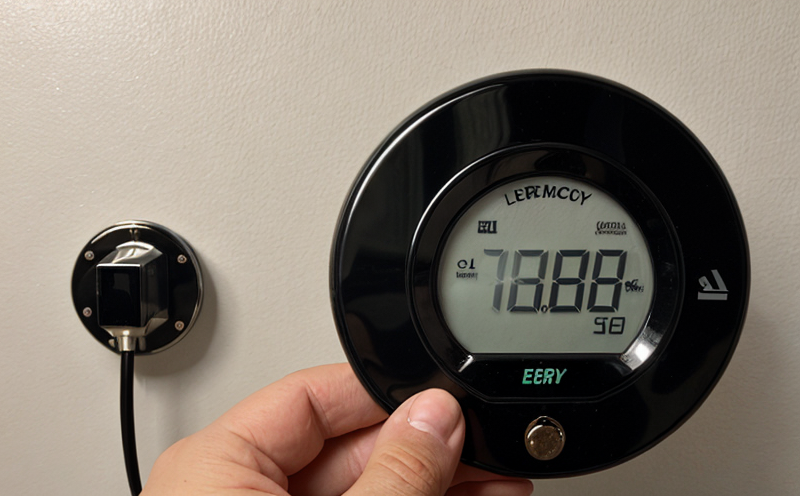ISO 16358 Energy Performance Testing for Air Conditioners
The ISO 16358 standard specifies a method to determine the energy efficiency of air conditioners. This service is essential for manufacturers, quality managers, and compliance officers who need to ensure their products meet stringent international standards.
Manufacturers often face challenges in meeting regulatory requirements, especially as global environmental concerns intensify. ISO 16358 provides a clear framework for testing the energy efficiency of air conditioners, which helps companies comply with regulations such as ENERGY STAR and EU ErP (Energy-using Products) directives. This standard is particularly important for air conditioners that are sold in markets where stringent energy efficiency requirements are enforced.
The testing methodology outlined in ISO 16358 involves measuring the electrical power consumption of an air conditioner under specified conditions, which can vary based on the specific model and its cooling capacity. The test aims to provide a consistent and reproducible method for determining the energy efficiency ratio (EER) or seasonal energy efficiency ratio (SEER). These metrics are crucial for consumers as they indicate how efficiently the equipment uses electricity.
Accurate testing is vital to ensure that air conditioners perform at their best, reducing unnecessary power consumption. This not only helps in minimizing operational costs but also contributes to environmental sustainability by promoting the use of energy-efficient products. Compliance with ISO 16358 can significantly enhance a company’s reputation and marketability, as consumers increasingly prioritize eco-friendly options.
Our laboratory adheres strictly to the procedures outlined in ISO 16358, ensuring that each test is conducted under controlled conditions that replicate real-world usage. By doing so, we provide manufacturers with reliable data that can be used for product development and marketing purposes.
The testing process typically involves several steps:
- Calibration of measurement instruments
- Setting up the air conditioner in a climate chamber
- Running tests under specified load conditions
- Data collection and analysis
The standard also includes provisions for handling various types of air conditioners, including split systems, central air conditioning units, and multi-split systems. This versatility makes ISO 16358 a comprehensive tool for testing different products in the electronics sector.
| Test Parameter | Description | Methodology |
|---|---|---|
| Electrical Power Consumption | The amount of electrical power consumed by the air conditioner under specified conditions. | The measurement is taken using calibrated instruments in a controlled environment. |
| Cooling Capacity | The cooling capacity of the air conditioner, measured in BTUs or watts. | This is determined during the test setup and verified throughout the testing process. |
| Outdoor Temperature | The temperature conditions under which the tests are conducted to simulate real-world use. | The outdoor temperature is controlled within a specific range to ensure consistent results. |
In conclusion, ISO 16358 energy performance testing for air conditioners is an indispensable tool for manufacturers and quality managers. By adhering to this standard, companies can ensure that their products meet stringent regulatory requirements while also contributing to environmental sustainability.
Why It Matters
Energy efficiency in air conditioning systems plays a pivotal role in reducing global energy consumption and mitigating the environmental impact of electricity use. ISO 16358 testing is crucial for several reasons:
- Compliance with Regulations: Many countries have implemented strict regulations to promote energy-efficient appliances, including air conditioners. Compliance ensures that products meet legal requirements and avoid potential fines or recalls.
- Eco-Friendly Products: By adhering to ISO 16358 standards, manufacturers can produce environmentally friendly products that contribute to reducing carbon footprints.
- Consumer Trust: Consumers increasingly value energy-efficient products. A reputation for producing eco-friendly and efficient air conditioners enhances brand image and consumer trust.
- Cost Savings: Energy-efficient air conditioners reduce operational costs by minimizing power consumption, leading to significant savings over the equipment’s lifecycle.
In summary, ISO 16358 testing is not just a regulatory requirement but also a strategic tool for manufacturers looking to enhance their product performance and market competitiveness.
Scope and Methodology
| Test Parameter | Description | Methodology |
|---|---|---|
| Electrical Power Consumption | The amount of electrical power consumed by the air conditioner under specified conditions. | The measurement is taken using calibrated instruments in a controlled environment. |
| Cooling Capacity | The cooling capacity of the air conditioner, measured in BTUs or watts. | This is determined during the test setup and verified throughout the testing process. |
| Outdoor Temperature | The temperature conditions under which the tests are conducted to simulate real-world use. | The outdoor temperature is controlled within a specific range to ensure consistent results. |
The ISO 16358 standard provides detailed procedures for conducting energy performance testing on air conditioners. The test setup involves placing the air conditioner in a climate chamber, where it operates under specified load conditions while measuring electrical power consumption and cooling capacity. The outdoor temperature is controlled to replicate real-world scenarios accurately.
The methodology also includes provisions for handling various types of air conditioners, including split systems, central air conditioning units, and multi-split systems. This versatility ensures that the testing process can accommodate different product categories within the electronics sector.
Quality and Reliability Assurance
- Instrument Calibration: All instruments used in the testing process are regularly calibrated to ensure accuracy.
- Data Verification: Data collected during the test is verified multiple times for consistency and accuracy.
- Environmental Controls: The climate chamber maintains precise temperature and humidity levels to simulate real-world conditions accurately.
- Test Replication: Tests are conducted under identical conditions to ensure consistent results.
- Data Analysis: Data is analyzed using sophisticated software tools to provide detailed reports on the energy efficiency of the air conditioner.
The quality and reliability assurance measures in place at our laboratory ensure that every test conducted adheres strictly to ISO 16358 standards. This commitment to accuracy and precision guarantees reliable data for manufacturers, compliance officers, and other stakeholders involved in product development and market analysis.





